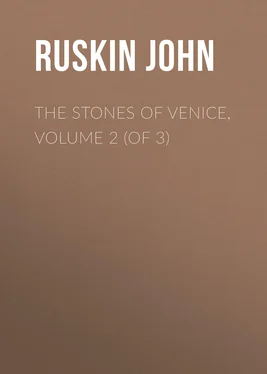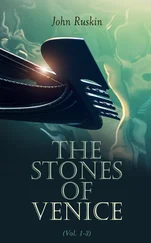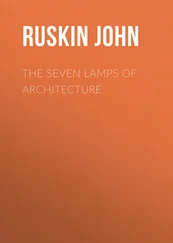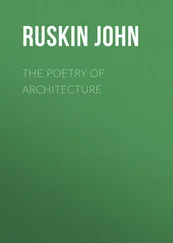John Ruskin - The Stones of Venice, Volume 2 (of 3)
Здесь есть возможность читать онлайн «John Ruskin - The Stones of Venice, Volume 2 (of 3)» — ознакомительный отрывок электронной книги совершенно бесплатно, а после прочтения отрывка купить полную версию. В некоторых случаях можно слушать аудио, скачать через торрент в формате fb2 и присутствует краткое содержание. Жанр: foreign_antique, foreign_home, architecture_book, literature_19, visual_arts, на английском языке. Описание произведения, (предисловие) а так же отзывы посетителей доступны на портале библиотеки ЛибКат.
- Название:The Stones of Venice, Volume 2 (of 3)
- Автор:
- Жанр:
- Год:неизвестен
- ISBN:нет данных
- Рейтинг книги:5 / 5. Голосов: 1
-
Избранное:Добавить в избранное
- Отзывы:
-
Ваша оценка:
- 100
- 1
- 2
- 3
- 4
- 5
The Stones of Venice, Volume 2 (of 3): краткое содержание, описание и аннотация
Предлагаем к чтению аннотацию, описание, краткое содержание или предисловие (зависит от того, что написал сам автор книги «The Stones of Venice, Volume 2 (of 3)»). Если вы не нашли необходимую информацию о книге — напишите в комментариях, мы постараемся отыскать её.
The Stones of Venice, Volume 2 (of 3) — читать онлайн ознакомительный отрывок
Ниже представлен текст книги, разбитый по страницам. Система сохранения места последней прочитанной страницы, позволяет с удобством читать онлайн бесплатно книгу «The Stones of Venice, Volume 2 (of 3)», без необходимости каждый раз заново искать на чём Вы остановились. Поставьте закладку, и сможете в любой момент перейти на страницу, на которой закончили чтение.
Интервал:
Закладка:
§ XIII. Of the body of the church, unhappily, they are few and obscure; but the general form and extent of the building, as shown in the plan, Plate I.fig. 2, are determined, first, by the breadth of the uninjured east end D E; secondly, by some remains of the original brickwork of the clerestory, and in all probability of the side walls also, though these have been refaced; and finally by the series of nave shafts, which are still perfect. The doors A and B may or may not be in their original positions; there must of course have been always, as now, a principal entrance at the west end. The ground plan is composed, like that of Torcello, of nave and aisles only, but the clerestory has transepts extending as far as the outer wall of the aisles. The semicircular apse, thrown out in the centre of the east end, is now the chief feature of interest in the church, though the nave shafts and the eastern extremities of the aisles, outside, are also portions of the original building; the latter having been modernized in the interior, it cannot now be ascertained whether, as is probable, the aisles had once round ends as well as the choir. The spaces F G form small chapels, of which G has a straight terminal wall behind its altar, and F a curved one, marked by the dotted line; the partitions which divide these chapels from the presbytery are also indicated by dotted lines, being modern work.
§ XIV. The plan is drawn carefully to scale, but the relation in which its proportions are disposed can hardly be appreciated by the eye. The width of the nave from shaft to opposite shaft is 32 feet 8 inches: of the aisles, from the shaft to the wall, 16 feet 2 inches, or allowing 2 inches for the thickness of the modern wainscot, 16 feet 4 inches, half the breadth of the nave exactly. The intervals between the shafts are exactly one fourth of the width of the nave, or 8 feet 2 inches, and the distance between the great piers which form the pseudo-transept is 24 feet 6 inches, exactly three times the interval of the shafts. So the four distances are accurately in arithmetical proportion; i.e.
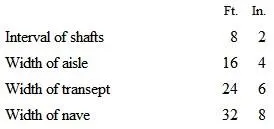
The shafts average 5 feet 4 inches in circumference, as near the base as they can be got at, being covered with wood; and the broadest sides of the main piers are 4 feet 7 inches wide, their narrowest sides 3 feet 6 inches. The distance a c from the outmost angle of these piers to the beginning of the curve of the apse is 25 feet, and from that point the apse is nearly semicircular, but it is so encumbered with renaissance fittings that its form cannot be ascertained with perfect accuracy. It is roofed by a concha, or semi-dome; and the external arrangement of its walls provides for the security of this dome by what is, in fact, a system of buttresses as effective and definite as that of any of the northern churches, although the buttresses are obtained entirely by adaptations of the Roman shaft and arch, the lower story being formed by a thick mass of wall lightened by ordinary semicircular round-headed niches, like those used so extensively afterwards in renaissance architecture, each niche flanked by a pair of shafts standing clear of the wall, and bearing deeply moulded arches thrown over the niche. The wall with its pillars thus forms a series of massy buttresses (as seen in the ground plan), on the top of which is an open gallery, backed by a thinner wall, and roofed by arches whose shafts are set above the pairs of shafts below. On the heads of these arches rests the roof. We have, therefore, externally a heptagonal apse, chiefly of rough and common brick, only with marble shafts and a few marble ornaments; but for that very reason all the more interesting, because it shows us what may be done, and what was done, with materials such as are now at our own command; and because in its proportions, and in the use of the few ornaments it possesses, it displays a delicacy of feeling rendered doubly notable by the roughness of the work in which laws so subtle are observed, and with which so thoughtful ornamentation is associated.
§ XV. First, for its proportions: I shall have occasion in Chapter V. to dwell at some length on the peculiar subtlety of the early Venetian perception for ratios of magnitude; the relations of the sides of this heptagonal apse supply one of the first and most curious instances of it. The proportions above given of the nave and aisles might have been dictated by a mere love of mathematical precision; but those of the apse could only have resulted from a true love of harmony.
In fig. 6, Plate I.the plan of this part of the church is given on a large scale, showing that its seven external sides are arranged on a line less than a semicircle, so that if the figure were completed, it would have sixteen sides; and it will be observed also, that the seven sides are arranged in four magnitudes, the widest being the central one. The brickwork is so much worn away, that the measures of the arches are not easily ascertainable, but those of the plinth on which they stand, which is nearly uninjured, may be obtained accurately. This plinth is indicated by the open line in the ground plan, and its sides measure respectively:
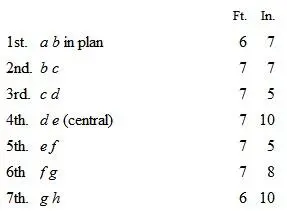
§ XVI. Now observe what subtle feeling is indicated by this delicacy of proportion. How fine must the perceptions of grace have been in those builders who could not be content without some change between the second and third, the fifth and sixth terms of proportion, such as should oppose the general direction of its cadence, and yet were content with a diminution of two inches on a breadth of seven feet and a half! For I do not suppose that the reader will think the curious lessening of the third and fifth arch a matter of accident, and even if he did so, I shall be able to prove to him hereafter that it was not, but that the early builders were always desirous of obtaining some alternate proportion of this kind. The relations of the numbers are not easily comprehended in the form of feet and inches, but if we reduce the first four of them into inches, and then subtract some constant number, suppose 75, from them all, the remainders 4, 16, 14, 19, will exhibit the ratio of proportion in a clearer, though exaggerated form.
§ XVII. The pairs of circular spots at b , c , d , etc., on the ground plan fig. 6, represent the bearing shafts, which are all of solid marble as well as their capitals. Their measures and various other particulars respecting them are given in Appendix 6. “Apse of Murano;” here I only wish the reader to note the coloring of their capitals. Those of the two single shafts in the angles ( a , h ) are both of deep purple marble; the two next pairs, b and g , are of white marble; the pairs c and f are of purple, and d and e are of white: thus alternating with each other on each side; two white meeting in the centre. Now observe, the purple capitals are all left plain; the white are all sculptured . For the old builders knew that by carving the purple capitals they would have injured them in two ways: first, they would have mixed a certain quantity of grey shadow with the surface hue, and so adulterated the purity of the color; secondly, they would have drawn away the thoughts from the color, and prevented the mind from fixing upon it or enjoying it, by the degree of attention which the sculpture would have required. So they left their purple capitals full broad masses of color; and sculptured the white ones, which would otherwise have been devoid of interest.
Читать дальшеИнтервал:
Закладка:
Похожие книги на «The Stones of Venice, Volume 2 (of 3)»
Представляем Вашему вниманию похожие книги на «The Stones of Venice, Volume 2 (of 3)» списком для выбора. Мы отобрали схожую по названию и смыслу литературу в надежде предоставить читателям больше вариантов отыскать новые, интересные, ещё непрочитанные произведения.
Обсуждение, отзывы о книге «The Stones of Venice, Volume 2 (of 3)» и просто собственные мнения читателей. Оставьте ваши комментарии, напишите, что Вы думаете о произведении, его смысле или главных героях. Укажите что конкретно понравилось, а что нет, и почему Вы так считаете.
